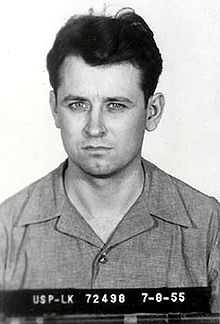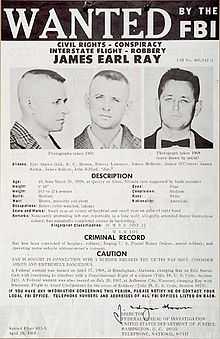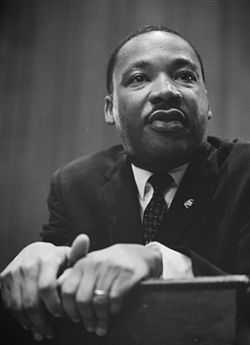James Earl Ray
| James Earl Ray | |
|---|---|
 Mug shot of Ray taken in 1955 | |
| Born |
March 10, 1928 Alton, Illinois, United States |
| Died |
April 23, 1998 (aged 70) Nashville, Tennessee, United States |
Criminal penalty | 99 years imprisonment (one year was added after his re-capture for a total of 100 years) |
| Spouse(s) | Anna Sandhu[1] (divorced) |
| Parent(s) |
James Gerald Ray Lucille Ray[2] |
| Conviction(s) |
Murder, prison escape, armed robbery, burglary |
James Earl Ray (March 10, 1928 – April 23, 1998) was an American criminal convicted of the assassination of civil rights and anti-war activist Martin Luther King, Jr.
Ray was convicted on March 10, 1969, after entering a guilty plea to forgo a jury trial. Had he been found guilty by jury trial, he would have been eligible for the death penalty.[3] He was sentenced to 99 years in prison. He later recanted his confession and tried unsuccessfully to gain access to a retrial. In 1998, Ray died in prison of complications due to chronic hepatitis C infection.
Early life
James Earl Ray was born to a poor family in Alton, Illinois, the son of Lucille (Maher) and George Ellis Ray. He had Welsh, Scottish, and Irish ancestry, and was raised Catholic.[4] He left school at age 15. He joined the US Army at the close of World War II and served in Germany.
Initial convictions and first escape from prison
He was convicted of his first crime, a burglary in California, in 1949. In 1952 he served two years for armed robbery of a taxi driver in Illinois. In 1955, he was convicted of mail fraud after stealing money orders in Hannibal, Missouri, and then forging them to take a trip to Florida. He served three years at Leavenworth Federal Penitentiary. In 1959 he was caught stealing $120 (equivalent to $1,000 in 2015) in an armed robbery of a St. Louis Kroger store.[5] Ray was sentenced to twenty years in prison for repeated offenses. He escaped from the Missouri State Penitentiary in 1967 by hiding in a truck transporting bread from the prison bakery.[6]
Activity in 1967
Following his escape, Ray stayed on the move, going first to St. Louis and then on to Chicago, Toronto, Montreal, and Birmingham. When he got to Alabama, Ray stayed long enough to buy a 1966 Ford Mustang and get an Alabama driver's license. He then drove to Mexico, stopping in Acapulco before settling down in Puerto Vallarta on October 19, 1967.[7] While in Mexico, Ray, using the alias Eric Starvo Galt, attempted to establish himself as a pornography director. Using mail-ordered equipment, he filmed and photographed local prostitutes. Frustrated with his results and jilted by the prostitute he had formed a relationship with, Ray left Mexico around November 16, 1967.[8]
Ray arrived in Los Angeles on November 19, 1967. While in L.A., Ray attended a local bartending school and took dance lessons.[9] His chief interest, however, was the George Wallace presidential campaign. Ray harbored a strong prejudice against African Americans and was quickly drawn to Wallace's segregationist platform. He spent much of his time in Los Angeles volunteering at the Wallace campaign headquarters in North Hollywood.[10] He also considered emigrating to Rhodesia (now Zimbabwe), where a white minority regime had unilaterally assumed independence from the United Kingdom in 1965.[11] The notion of residing in Rhodesia continued appealing to Ray for several years afterward, and would be his intended destination after King's assassination.[12]
Activity in early 1968
On March 5, 1968, Ray underwent a facial reconstruction (rhinoplasty), performed by Dr. Russell Hadley.[13] On March 18, 1968, Ray left Los Angeles and began a cross-country drive to Atlanta, Georgia.[14]
Arriving in Atlanta on March 24, 1968, Ray checked into a rooming house.[15] He eventually bought a map of the city. FBI agents later found this map when they searched the room in which he was staying in Atlanta. On the map, the locations of the church and residence of Martin Luther King Jr. were allegedly circled.[16] However, according to Dr. William Pepper, "The Atlanta map is nowhere related to Dr. King's residence. It is three oblong circles that covered general areas."[17]
Ray was soon on the road again, and drove his Mustang to Birmingham, Alabama. There, on March 30, 1968, he bought a Remington Gamemaster 760 .30-06-caliber rifle and a box of 20 cartridges from the Aeromarine Supply Company. He also bought a Redfield 2x7 scope, which he had mounted to the rifle. He told the store clerks that he was going on a hunting trip with his brother. Ray had continued using the Galt alias after his stint in Mexico, but when he made this purchase, he gave his name as Harvey Lowmeyer.[18]
After buying the rifle and accessories, Ray drove back to Atlanta. An avid newspaper reader, Ray passed his time reading the Atlanta Constitution. The paper reported King's planned return trip to Memphis, Tennessee, which was scheduled for April 1, 1968. On April 2, 1968, Ray packed a bag and drove to Memphis.[19]
Assassination of Martin Luther King, Jr.


Martin Luther King was killed by a single rifle shot on April 4, 1968, while standing on the second-floor balcony of the Lorraine Motel in Memphis, Tennessee. Shortly after the shot was fired, witnesses saw a man believed to be James Earl Ray fleeing from a rooming house across the street from the Lorraine Motel. Ray had been renting a room in the house at the time. A package was dumped close to the site that included a rifle and binoculars, both found with Ray's fingerprints.
Capture and trial
Ray fled north to Toronto, Ontario, where he hid out for a month and acquired a Canadian passport under the false name of Ramon George Sneyd.[20] On June 8, 1968, a little more than two months after King's death, Ray was captured at London's Heathrow Airport while trying to leave the United Kingdom on the false Canadian passport. At check-in, the ticket agent noticed the name on his passport—Sneyd—was on a Royal Canadian Mounted Police watchlist.[21] At the airport, officials noticed that Ray carried another passport under a second name. The UK quickly extradited Ray to Tennessee, where he was charged with King's murder. He confessed to the crime on March 10, 1969, his 41st birthday,[22] and after pleading guilty was sentenced to 99 years in prison.[23]
Denial of confession
Three days later, he recanted his confession. Ray had entered a guilty plea on the advice of his attorney, Percy Foreman, in order to avoid a potential trial conviction, which could have led to a sentence of death. The method of execution in Tennessee at the time was electrocution.
Ray fired Foreman as his attorney, and derisively called him "Percy Fourflusher" thereafter.[24] Ray began claiming that a man he had met in Montreal, who used the alias "Raul", had been deeply involved. Instead he asserted that he did not "personally shoot Dr. King", but may have been "partially responsible without knowing it", hinting at a conspiracy. Ray sold this version of King's assassination and his own flight to William Bradford Huie. Huie investigated this story and discovered Ray sometimes lied. Ray told Huie he purposefully left the rifle with his fingerprints on it in plain sight because he wanted to become a famous criminal. Ray was convinced he was so smart that he would not be caught.[3] He believed Governor of Alabama George Wallace would soon be elected President, and Ray would only be confined for a short time.[3] He spent the remainder of his life unsuccessfully attempting to withdraw his guilty plea and secure a trial.
Second escape from prison
On June 11, 1977, Ray made his second appearance on the FBI Most Wanted Fugitives list, this time as the 351st entry. He and six other convicts had escaped from Brushy Mountain State Penitentiary in Petros, Tennessee, on June 10. They were recaptured on June 13 and returned to prison.[25] A year was added to Ray's previous sentence, to total 100 years.
Conspiracy allegations
Ray had hired Jack Kershaw as his attorney, who promoted Ray's claim that he was not responsible for the shooting, which was said to have been the result of a conspiracy of the otherwise unidentified man named "Raul". Kershaw and his client met with representatives of the United States House Select Committee on Assassinations and convinced the committee to run ballistics tests—which ultimately proved inconclusive—that they felt would show that Ray had not fired the fatal shot.[26] Kershaw claimed that the escape was additional proof that Ray had been involved in a conspiracy that had provided him with the outside assistance he would have needed to break out of jail. Kershaw convinced Ray to take a polygraph test as part of an interview with Playboy. The magazine said that the test results showed "that Ray did, in fact, kill Martin Luther King Jr. and that he did so alone." Ray fired Kershaw after discovering that the attorney had been paid $11,000 by the magazine in exchange for the interview and hired conspiracy theorist Mark Lane to provide him with legal representation.[26]
Later developments
In 1997, King's son Dexter met with Ray, asking him, "I just want to ask you, for the record, um, did you kill my father?" Ray replied, "No-no I didn't," and King tells Ray that he, along with the King family, believed him; the King family also urged for a new trial for Ray.[27][28][29] Loyd Jowers, a restaurant owner in Memphis, was brought to civil court and sued as being part of a conspiracy to murder Martin Luther King. Jowers was found legally liable, and the King family accepted $100 in restitution, an amount chosen to show that they were not pursuing the case for financial gain.
Dr. William Pepper, a friend of King in the last year of his life, represented Ray in a televised mock trial in an attempt to get him the trial he never had. Pepper later represented the King family in a wrongful death civil trial against Loyd Jowers. The King family has since concluded that Ray did not have anything to do with the murder of Martin Luther King, Jr.[30]
Death
Ray died in prison on April 23, 1998, at the age of 70, from complications related to kidney disease and liver failure caused by hepatitis C. Ray was survived by seven siblings. His brother Jerry Ray told CNN that his brother did not want to be buried or have his final resting place in the United States because of "the way the government has treated him." Ray was cremated and his ashes were flown to Ireland, the home of his family's ancestors.[31] Ten years later, Ray's other brother, John Larry Ray, co-authored a book with Lyndon Barsten, titled Truth At Last: The Untold Story Behind James Earl Ray and the Assassination of Martin Luther King Jr. revealing what the former author knew about the assassination.[27]
Name mix up
Ray was once erroneously honoured during a parade which intended to praise the actor James Earl Jones. Lauderhill, a suburb of Fort Lauderdale, Florida, accidentally created a plaque in January 2002 which read 'Thanks James Earl Ray for keeping the dream alive'.[32]
Notes
- ↑ Leviton, Joyce (30 October 1978). "Why Did a Nice Girl Like Anna Sandhu Wed James Earl Ray? 'I Love Him,' She Says". People. Retrieved 4 January 2015.
- ↑ Jerome, Richard (11 May 1998). "Dead Silence". People. Retrieved 4 January 2015.
- ↑ 3.0 3.1 3.2 Huie, William Bradford (1997). He Slew the Dreamer: My Search for the Truth About James Earl Ray and the Murder of Martin Luther King (Revised ed.). Montgomery: Black Belt Press. ISBN 978-1-57966-005-5.
- ↑
- ↑ The Martin Luther King Assassination – Philip H. Melanson – Google Books. Books.google.com. Retrieved 2014-06-27.
- ↑ Gribben, Mark. "James Earl Ray: The Man Who Killed Dr. Martin Luther King, chapter 3". truTV Crime Library. truTV. Retrieved 25 June 2006.
- ↑ Sides, Hampton (2010). Hellhound on His Trail: The Stalking of Martin Luther King Jr. and the Hunt for His Assassin. New York: Doubleday. ISBN 978-0-385-52392-9., page 27
- ↑ Sides, p. 33.
- ↑ Sides, pp. 47–48.
- ↑ Sides, p. 60.
- ↑ Sides, pp. 62–63.
- ↑ Gerald Horne. From the Barrel of a Gun: The United States and the War against Zimbabwe, 1965–1980 (2000 ed.). University of North Carolina Press. p. 24. ISBN 978-0807849033.
- ↑ Sides, pp. 87–88.
- ↑ Sides, pp. 90–91.
- ↑ Sides, p. 98.
- ↑ Sides, p. 302.
- ↑ "Civil Case: King Family versus Jowers | The Martin Luther King Jr. Center for Nonviolent Social Change". Thekingcenter.org. Retrieved 2014-06-27.
- ↑ Sides, pp. 118–120.
- ↑ Sides, pp. 128–129.
- ↑ "Why assassin James Earl Ray returned to Toronto | Toronto Star". Thestar.com. 2010-06-06. Retrieved 2014-06-27.
- ↑ Borrell, Clive (28 June 1968). "Ramon Sneyd denies that he killed Dr King". The Times (London). p. 2. Retrieved 13 Jan 2009.
- ↑ Waters, David; Charlier, Tom (24 April 1998). "Log Cabin Democrat: King assassin Ray dies after lifelong legal fight 4/24/98". Retrieved 9 December 2014.
- ↑ "1969: Martin Luther King's killer gets life". On This Day 1950–2005: 10 March (British Broadcasting Corporation (BBC)). March 10, 1969.
- ↑ Ubani, Lumumba Umunna (2011). Afrikan Mind Reconnection and Spiritual Re-Awakening, Volume 1. Xlibris Corporation. ISBN 9781456841324.
- ↑ "Federal Bureau of Investigation – History of Knoxville Office". FBI. Archived from the original on 24 May 2008. Retrieved 25 June 2008.
- ↑ 26.0 26.1 Martin, Douglas (24 Sep 2010). "Jack Kershaw Is Dead at 96; Challenged Conviction in King's Death". New York Times. Retrieved 25 Sep 2010.
- ↑ 27.0 27.1 John Ray ( brother of James Earl) on Fox at YouTube
- ↑ Today in History March 27 at YouTube
- ↑ Sack, Kevin (28 March 1997). "Dr. King's Son Says Family Believes Ray Is Innocent". The New York Times. Retrieved 4 January 2015.
- ↑ "Complete Transcript of the Martin Luther King, Jr. Assassination Conspiracy Trial". The King Center. Retrieved 17 January 2012.
- ↑ "Autopsy confirms Ray died of liver failure". CNN (Nashville). 24 Apr 1998. Retrieved 25 June 2008.
- ↑ http://www.telegraph.co.uk/news/worldnews/northamerica/usa/1381829/Luther-King-assassin-honoured-by-mistake.html
References
- "James Gang". Snopes.com. 17 Jan 2010. Retrieved 11 Aug 2010.
- Petras, Kathryn; Petras, Ross (21 Oct 2003). Unusually Stupid Americans: A Compendium of All-American Stupidity. Villard. ISBN 978-0-8129-7082-1. Retrieved 11 Aug 2010.
Further reading
- Ray, James Earl, Who Killed Martin Luther King?: The True Story by the Alleged Assassin, Washington D.C.: National Press Books, 1992, ISBN 0-915765-93-4
- Pepper, William, An Act of State: The Execution of Martin Luther King
- Posner, Gerald, Killing the Dream: James Earl Ray and the Assassination of Martin Luther King, Jr.
- Ray, James Earl with Saussy, Tupper, Tennessee Waltz: The Making of a Political Prisoner
- McMillan, George, The Making of an Assassin
- Heathrow, John, Why Did He Do It?
- Melanson, Dr. Philip H., The Martin Luther King Assassination: New Revelations on the Conspiracy and Cover-Up, 1968–1991
- Green, Jim, Blood and Dishonor on a Badge of Honor
External links
- Roads to Memphis (American Experience, first aired Monday, May 3, 2010) – Public Broadcasting System (PBS).
- James Earl Ray at Find a Grave
|
